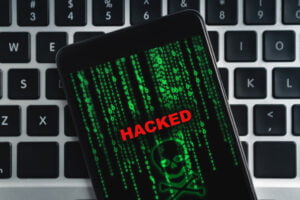Have you ever wondered what it takes to be a hacking forensic investigator?
Step into the thrilling world of cybercrime investigation as we uncover the secrets and inner workings of this fascinating profession. From tracking down digital criminals to analysing complex data trails, these specialised experts play a crucial role in solving cybercrimes. In this post, we will delve deep into the world of a hacking forensic investigator. We will explore the tools and techniques they use to uncover hidden digital evidence and follow the trail of hackers. From analysing network logs to deciphering encrypted messages, these investigators are on the forefront of digital crime-fighting.

Computer Hacked and Security Breach
As we peel back the layers, we will discover the skills and expertise required to excel in this field. Attention to detail, problem-solving abilities, and a solid understanding of computer systems are just a few of the key traits needed to succeed.
Role and responsibilities of a hacking forensic investigator
A hacking forensic investigator is a highly skilled professional responsible for investigating cybercrimes and gathering digital evidence to aid in the prosecution of criminals. Their role encompasses a wide range of responsibilities and requires a deep understanding of computer systems, networks, and digital forensics.
Gathering and Preserving Evidence
One of the primary responsibilities of a hacking forensic investigator is to collect and preserve digital evidence. This involves securing the crime scene, making digital copies of relevant data, and ensuring the integrity of the evidence throughout the investigation process. This meticulous approach is crucial to ensuring the admissibility of evidence in a court of law.
Analysing Digital Evidence
Once the evidence has been gathered, a hacking forensic investigator must carefully analyse it to identify patterns, connections, and potential leads. This may involve examining network logs, analysing metadata, or decrypting encrypted files. The ability to uncover hidden information and piece together the puzzle is essential in solving cybercrimes.
Reporting and Presenting Findings
A hacking forensic investigator must be able to clearly communicate their findings to stakeholders, including law enforcement agencies, legal teams, and private customers. This requires strong written and verbal communication skills, as well as the ability to present complex technical information in a clear and concise manner.

Smart Phone Hacked: How To Investigate Mobile Hacking
Tools and techniques used in hacking forensic investigation.
Hacking forensic investigators rely on a variety of tools and techniques to carry out their work. These tools help them gather, analyse, and interpret digital evidence, enabling them to uncover the truth behind cybercrimes. Let’s explore some of the most commonly used tools and techniques in hacking forensic investigation.
Forensic Imaging Tools
Forensic imaging tools are used to create bit-by-bit copies of digital storage media, such as hard drives or mobile devices. These tools ensure the integrity of the original evidence while allowing investigators to work with a duplicate copy. Popular forensic imaging tools include FTK Imager, EnCase, Cellebrite Digital Collector and dd.
Network Analysis Tools
Network analysis tools help investigators examine network traffic and identify suspicious activities or anomalies. These tools can capture and analyse packets of data, allowing investigators to trace the source of an attack, identify compromised systems, and reconstruct the sequence of events. Wireshark, tcpdump, and NetworkMiner are commonly used network analysis tools.
Password Cracking Tools
Password cracking tools are used to recover passwords or encryption keys from protected files or systems. These tools leverage various techniques, such as dictionary attacks, brute-force attacks, or rainbow table attacks, to crack passwords and gain access to encrypted data. Popular password cracking tools include John the Ripper, Hashcat, Hydra, and Ophcrack.
Steps involved in a hacking forensic investigation process
Hacking forensic investigations follow a systematic process to ensure a thorough and efficient examination of digital evidence. While the specific steps may vary depending on the nature of the case, there are common stages that every hacking forensic investigation typically includes. Let’s explore the key steps involved in a hacking forensic investigation process.
Identification and Assessment
The first step in a hacking forensic investigation is to identify the nature of the incident and assess its potential impact. This involves gathering information from the affected system or network, interviewing relevant individuals, and determining the scope of the investigation.
Collection and Preservation
Once the incident has been identified, the next step is to collect and preserve digital evidence. This includes securing the scene, documenting the state of the system or network, and creating forensic images of relevant storage media. The integrity of the evidence is crucial, and strict procedures must be followed to ensure its admissibility in court.
Analysis and Examination
During the analysis and examination phase, investigators carefully examine the collected evidence using various forensic tools and techniques. This may involve analysing network logs, examining file metadata, recovering deleted files, or decrypting encrypted data. The goal is to uncover any hidden information that could provide insights into the perpetrator’s activities.
Reconstruction and Reporting
Based on the findings from the analysis phase, investigators reconstruct the sequence of events leading up to the incident. This involves piecing together the evidence to create a clear timeline and understanding of what occurred. The findings are then documented in a comprehensive report that can be used by law enforcement agencies, legal teams, company directors, private customers or other stakeholders.
Common types of digital evidence in hacking cases
Digital evidence plays a crucial role in hacking forensic investigations as it provides valuable insights into the activities of the perpetrators. Understanding the different types of digital evidence encountered in hacking cases can help investigators build a strong case against cybercriminals. Let’s explore some of the common types of digital evidence found in hacking cases.
Network Logs
Network logs record information about network traffic, including IP addresses, timestamps, and the type of traffic. Analysing network logs can help investigators identify suspicious activities, trace the origin of an attack, and determine the extent of the compromise. Network logs can provide valuable evidence linking a specific individual or system to a cybercrime.
Malware and Exploit Artifacts
Malware and exploit artifacts are often left behind by attackers and can provide valuable clues about their methods and intentions. These artifacts may include malicious files, exploit code, or command and control servers. Analysing malware and exploit artifacts can help investigators identify the tools and techniques used by the attackers and potentially link them to other incidents.
Digital Communication Records
Digital communication records, such as emails, chat logs, or instant messages, can provide insights into the planning, coordination, and execution of a cyberattack. These records can help investigators identify the individuals involved, their roles, and their motivations. Analysing digital communication records can be instrumental in building a strong case against cybercriminals.
Challenges faced by hacking forensic investigators
Hacking forensic investigators face numerous challenges in their quest to uncover the truth behind cybercrimes. The rapidly evolving nature of technology, the sophistication of cybercriminals, and the global nature of cyberattacks present unique obstacles that investigators must overcome. Let’s explore some of the key challenges faced by hacking forensic investigators.
Digital Footprint Erasure
Cybercriminals are becoming increasingly adept at covering their tracks and erasing their digital footprints. They may employ sophisticated techniques, such as encryption, steganography, or data obfuscation, to hide their activities. Investigators must stay ahead of these techniques and constantly update their knowledge and skills to overcome the challenge of digital footprint erasure.
Global Jurisdictional Issues
Cybercrimes often transcend national boundaries, making it difficult for investigators to navigate the complex landscape of international laws and jurisdictions. Cooperation and coordination between law enforcement agencies from different countries are crucial to successfully prosecuting cybercriminals. However, differences in legal frameworks, cultural norms, and language barriers can present significant challenges.
Rapidly Evolving Technology
Technology is evolving at an unprecedented pace, and cybercriminals are quick to adapt and exploit new vulnerabilities. Hacking forensic investigators must constantly stay updated on the latest trends, tools, and techniques in cybersecurity to effectively investigate and prevent cybercrimes. This requires continuous learning, professional development, and collaboration with industry experts.
Importance of digital forensics in cybersecurity
Digital forensics plays a pivotal role in cybersecurity by helping to identify, investigate, and prevent cybercrimes. The insights gained from digital forensics can be used to strengthen security measures, detect vulnerabilities, and prosecute cybercriminals. Let’s explore the importance of digital forensics in cybersecurity.
Training and certifications for becoming a hacking forensic investigator
Becoming a hacking forensic investigator requires a combination of technical skills, knowledge, and practical experience. While there is no single path to becoming a hacking forensic investigator, there are several training programs and certifications that can help aspiring investigators develop the necessary expertise. Let’s explore some of the popular training and certification options for becoming a hacking forensic investigator.
Certified Forensic Computer Examiner (CFCE)
The CFCE certification, offered by the International Association of Computer Investigative Specialists (IACIS), is a globally recognised certification for digital forensic professionals. The certification covers a wide range of topics, including computer forensics, network forensics, mobile device forensics, and incident response. The CFCE certification requires candidates to pass a rigorous examination and demonstrate their practical skills.
Certified Hacking Forensic Investigator (CHFI)
The CHFI certification, offered by EC-Council, is specifically designed for professionals involved in digital forensics and incident response. The certification covers various aspects of hacking forensic investigation, including evidence collection and preservation, forensic analysis, and reporting. The CHFI certification validates the candidate’s knowledge and skills in the field of hacking forensic investigation.
Computer Forensics Lab employs certified hacking forensic investigators who can assist its clients. Use our secure service inquiry form or call 02071646915 if you need to speak to a hacking forensic investigator.